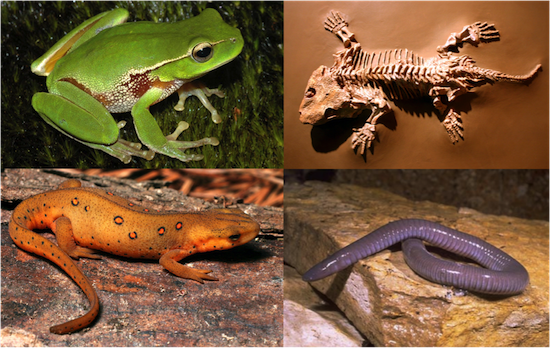
Amphibia Notes

Amphibians are tetrapod vertebrates of the class Amphibia. Modern amphibians inhabit a wide variety of habitats with most species living within terrestrial, fossorial, arboreal or freshwater aquatic ecosystems. Amphibians typically start out as larvae living in water, but some species have developed behavioural adaptations to bypass this. The young generally undergo metamorphosis from larva with gills to an adult air-breathing form with lungs. Amphibians use their skin as a secondary respiratory surface and some small terrestrial salamanders and frogs lack lungs and rely entirely on their skin. They are superficially similar to reptiles but, along with mammals and birds, reptiles are amniotes and do not require water bodies in which to breed. With their complex reproductive needs and permeable skins, amphibians are often ecological indicators and in recent decades there has been a dramatic decline in amphibian populations for many species around the globe.
The first major groups of amphibians developed in the Devonian period, around 370 million years ago, from lobe-finned fish which were similar to the modern coelacanth and lungfish. These ancient lobe-finned fish had evolved multi-jointed leg-like fins with digits that enabled them to crawl along the sea bottom. Some fish had developed primitive lungs to help them breathe air when the stagnant pools of the Devonian swamps were low in oxygen. They could also use their strong fins to hoist themselves out of the water and onto dry land if circumstances so required. Eventually, their bony fins would evolve into limbs and they would become the ancestors to all tetrapods, including modern amphibians, reptiles, birds, and mammals. Despite being able to crawl on land, many of these prehistoric fish still spent most of their time in the water. They had started to develop lungs, but still breathed predominantly with gills.
During the Carboniferous, amphibian dominance gave way to reptiles and amphibians were further devastated by the Permian—Triassic extinction event. During the Triassic Period (250 to 200 million years ago), the reptiles continued to out-compete the amphibians, leading to a reduction in both the amphibians' size and their importance in the biosphere. The relative scarcity of fossil evidence precludes precise dating, but the most recent molecular study, based on multilocus sequence typing, suggests a Late Carboniferous/Early Permian origin for extant amphibians.